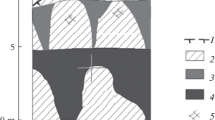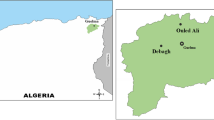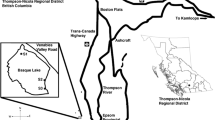Abstract
During the “Guaynaut” oceanographic cruise performed by IFREMER in November 1991, sediment cores were collected from high-temperature and petroleum-rich deposits in an active hydrothermal zone, at the Guaymas basin (Central gulf of California). Those samples were collected by the French deep-sea manned submersible “Nautile” at a depth of 2000 meters. Four sediment cores of 20–40-cm length were drilled at the bottom of a block assemblage of active smokers inside sediments whose temperatures were 3.5°C on the top to 105°C at 20 cm depth. They were subsampled in 22 slices of 5-cm thickness and used for isolation of heterotrophic hyperthermophilic microorganisms, after inoculation in sulfur-free SME liquid medium. From those enrichments 18 isolates were obtained, 2 growing at 95°C and 16 at 80°C, and their taxonomic characterization was undertaken. Lipid analysis indicated the presence of diethers and tetraethers in the cell walls and membranes, characteristic of Archaebacteria. Examinations by scanning electron microscopy showed that isolates were cocci of heterogeneous sizes (diameter from 0.1 to 0.5 micrometers) or thick, piled-up discs 0.5 μm thick and 1 μm in diameter. Both forms were embedded in a dense fiber network. Physiologically they were found to be anaerobic, heterotrophic, and hyperthermophilic (80°–95°C). Determination of the DNA base composition resulted in G + C mol % values ranging from 36 to 57. Qualitative hybridizations of the 18 isolate DNAs with hyperthermophilic Archaebacteria reference strain DNAs showed that hybridizations occurred neither with the two species of Pyrococcus nor with the two species of Desulfurococcus, nor with Staphylothermus marinus. On the other hand, all isolates hybridized with at least one of the three species of Thermococcus tested (T. celer, T. stetteri, T. litoralis). Restriction polymorphism on a PCR-amplified fragment of the rrn operon showed that 12 isolates had the same profile as T. celer and T. stetteri, 4 isolates had the same profile as T. litoralis, and 2 had new profiles, suggestive that they are new species.
Similar content being viewed by others
Literature Cited
Balch WE, Wolfe RS (1976) New approach to the cultivation of methanogenic bacteria: 2-mercaptoethane-sulfonic acid (HS-CoM)-dependent growth of Methanobacterium ruminantium in a pressurized atmosphere. Appl Environ Microbiol 32:781–791
Balch WE, Fox GE, Magrum LJ, Woese CR, Wolfe WS (1979) Methanogens: reevaluation of a unique biological group. Microbiol Rev 43:260–296
Bligh EG, Dyer WJ (1959) A rapid method for lipid extraction and purification. Can J Microbiol 35:911–917
Burggraf S, Jannasch HW, Nicolaus B, Stetter KO (1990) Archaeglobus profondus sp. nov. represents a new species within the sulfate-reducing archaebacteria. Syst Appl Microbiol 13:24–28
Canganella F, Jones WJ (1994) Microbial characterization of thermophilic Archaea isolated from the Guaymas Basin hydrothermal vent. Curr Microbiol 28:299–306
Corliss JB, Ballard RD (1977) oases of life in the cold abyss. Natl Geogr Mag 152:441–450
De Rosa M, Gambacorta A, Trincone A, Basso A, Zillig W, Holz I (1987) Lipids of Thermococcus celer, a sulfur-reducing Archaebacterium: structure and biosynthesis. Syst Appl Microbiol 9:1–5
Erauso G, Reysenbach AL, Godfroy A, Meunier JR, Crump B, Partensky F, Baross JA, Marteinsson V, Barbier G, Pace NR, Prieur D (1993) Pyrococcus abyssi sp. nov., a new hyperthermophilic archaeon isolated from a deep-sea hydrothermal vent. Arch Microbiol 160:338–349
Fiala G, Stetter KO (1986) Pyrococcus furiosus sp. nov. represents a novel genus of marine heterotrophic archaebacteria growing optimally at 100°C. Arch Microbiol 145:56–61
Fiala G, Stetter KO, Jannasch HW, Langworthy TA, Madon J (1986) Staphylothermus marinus sp. nov. represents a novel genus of extremely thermophilic submarine heterotrophic archaebacteria growing up to 98°C. Syst Appl Microbiol 8:106–113
Hobbie JE, Daley RJ, Jasper S (1977) Use of nucleopore filters for counting bacteria by fluorescence microscopy. Appl Environ Microbiol 33(5):1225–1228
Huber R, Stoffers P, Cheminee JL, Richnow HH, Stetter KO (1990) Hyperthermophilic archaebacteria within the crater and open sea-plume of erupting MacDonald seamount. Nature 345:179–182
Jannasch HW, Wirsen CO, Molyneaux SJ, Langworthy TA (1988) Extremely thermophilic fermentative archaebacteria of the genus Desulfurococcus from deep sea hydrothermal vents. Appl Env Microbiol 54:1203–1209
Jones WJ, Leigh JA, Mayer F, Woese CR, Wolfe RS (1983) Methanococcus jannaschii sp. nov., an extremely thermophilic methanogen from a submarine hydrothermal vent. Arch Microbiol 136:254–261
Kates M (1964) Bacterial lipids. Adv Lipid Res 2:17–90
Kurr M, Huber R, König H, Jannasch HW, Fricke H, Trincone A, Kristjansson JK, Stetter KO (1991) Methanopyrus kandleri, gen. and sp. nov. represents a novel group of hyperthermophilic methanogens, growing at 110°C. Arch Microbiol 156:239–247
Langworthy TA, Holzer G, Zeikus JG, Tornabene TG (1983) Iso and anteiso-branched glycerol diethers of the thermophilic anaerobe Thermodesulfotobacterium commune. Syst Appl Microbiol 4:1–17
Mandel M, Marmur J (1968) Use of ultraviolet absorbancetemperature profile for determining the guanine plus cytosine content of DNA. Methods Enzymol 12B:195–206
Marchand M, Termonia M, Caprais JC, Wybauw M (1990) Purge and trap GC-MS analysis of volatile organic compounds from the Guaymas Basin hydrothermal site (gulf of California). Analusis 22:326–331
Marmur J (1961) A procedure for isolation of deoxyribonucleic acid from microorganisms. J Mol Biol 3:208–218
Marmur J, Doty P (1962) Determination of the base composition of deoxyribonucleic acid from its thermal denaturation temperature. J Mol Biol 5:109–118
Meunier JR (1994) Thèse de Docteur-Ingénieur de L'Institut National Agronomique Paris-Grignon, Biodiversité et systématique des populations de micro-organismes thermophiles isolés d'écosystèmes hydrothermaux océaniques abyssaux
Miroshnichenko ML, Bonch-Osmolovskaya EA, Neuner A, Kostrikina NA, Chernych NA, Alekseev VA (1989) Thermococcus stetteri sp. nov., a new extremely thermophilic marine sulfur metabolizing archaebacterium. Syst Appl Microbiol 12:257–262
Neuner AM, Jannasch HW, Belkin S, Stetter KO (1990) Thermococcus litoralis sp. nov.: a new species of extremely thermophilic marine archaebacteria. Arch Microbiol 153:205–207
Pley U, Schipka J, Gambacorta A, Jannasch HW, Fricke H, Rachel R, Stetter KO (1991) Pyrodictium abyssi sp. nov. represents a novel heterotrophic marine archaeal hyperthermophile growing at 110°C. Syst Appl Microbiol 14:245–253
Sambrook J, Fritsch EF, Maniatis T (1989) Molecular cloning. A laboratory manual, 2nd edn. Cold Spring Harbor, N.Y.: Cold Spring Harbor Laboratory Press
Simoneit BRT, Mazurek MA, Brenner S, Crips PT, Kaplan IR (1979) Organic geochemistry of recent sediments from Guaymas Basin, Gulf of California. Deep Sea Res 26A:879–891
Stetter KO, König H, Stackebrandt E (1983) Pyrodictium gen. nov., a new genus of submarine disc-shaped sulphur reducing archaebacteria growing optimally at 105°C. Syst Appl Microbiol 4:535–551
Tetsuo K, Yi S, Teruhiko A, Toshiaki K, Koki H (1993) Thermococcus profundus: a new species of extremely thermophilic Archaebacteria isolated from a deep-sea hydrothermal vent. Abstracts of the International Workshop on Molecular Biology and Biotechnology of Extremophiles and Archaebacteria 1993:11
White DC, Nickels JS, King JD, Bobbie RJ (1979) Determination of the sedimentary microbial biomass by extractable lipid phosphate. Oecologia 40:51–62
Zillig W, Holz I, Janekovic D, Schafer W, Reiter WD (1983) The archaebacterium Thermococcus celer represents a novel genus within the thermophilic branch of the archaebacteria. Syst Appl Microbiol 4:88–94
Zillig W, Holz I, Klenk HP, Wunderl S, Janekovic D, Imsel E, Haas B (1987) Pyrococcus woesi, sp. nov., an ultra-thermophilic marine archaebacterium, representing a novel order, Thermococcales. Syst Appl Microbiol 9:62–70
Author information
Authors and Affiliations
Rights and permissions
About this article
Cite this article
Antoine, E., Guezennec, J., Meunier, J.R. et al. Isolation and characterization of extremely thermophilic archaebacteria related to the genus Thermococcus from deep-sea hydrothermal guaymas basin. Current Microbiology 31, 186–192 (1995). https://doi.org/10.1007/BF00293552
Issue Date:
DOI: https://doi.org/10.1007/BF00293552




